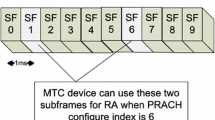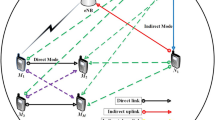Abstract
Introducing Machine-to-Machine (M2M) communications over traditional 4G cellular networks make the cellular random access channel more congested and collision-prone. In order to resolve this random access congestion, we propose RoBiN - Random access using Border router in M2M cellular Networks. RoBiN proposes an architectural modification of introducing small cells, called Border Routers (BR), in cellular networks, with complete frequency reuse capability. We formulate the aforementioned challenge in terms of collision probability and system capacity. Subsequently, we propose an efficient solution for M2M communications in cellular networks. Exhaustive mathematical analysis shows that RoBiN significantly improves the random access success probability, by 50 % over existing 4G cellular systems. Simulation results on typical 4G networks corroborate our mathematical analysis and demonstrate almost 15 dB increase in Signal-to-Interference-plus-Noise Ratio (SINR) and 3 times throughput improvements over legacy 4G cellular systems. Furthermore, RoBiN also achieves 50 %−80 % improvement in collision probability over existing time alignment matching work.














Similar content being viewed by others
References
Wu G, Talwar S, Johnsson K, Himayat N, Johnson K D (2011) Intel & P. popovski, M2M: From mobile to embedded internet. IEEE Commun Mag 49(4):36–43
Ericsson (2011) More than 50 billion connected devices, white paper, available online: goo.gl/vjYO0 or http://goo.gl/nRdzLg
Cisco (2011) The Internet of Things, How the Next Evolution of the Internet Is Changing Everything, white paper, Available online: http://www.cisco.com/web/about/ac79/docs/innov/IoT_IBSG_0411FINAL.pdf
Laya A, Alonso L, Alonso-Zarate J (2014) Is the Random Access Channel of LTE and LTE-a Suitable for M2M Comm. A Survey of Alternatives. IEEE Commun Surv Tutorials 16(1):4–16
Saquib N, Hossain E, Kim D I (2013) Fractional frequency reuse for interference management in LTE-advanced hetnets. IEEE Wirel Commun 20(2):113–122
Wang L-C, Yeh C-J (2011) 3-Cell network MIMO architectures with sectorization and fractional frequency reuse. IEEE J Sel Areas Commun 29(6):1185–1199
Innovations Telesystem (2010) LTE In a nutshell. white paper
3GPP TS 36.101, TS 36.101 V8.15.0 Evolved Universal Terrestrial Radio Access (E-UTRA): User Equipment (UE) radio transmission and reception
(2012) 3GPP TS 136 211 V10.4.0 2012 Evolved Universal Terrestrial Radio Access (E-UTRA):Physical channels and modulation pp.46–47
3GPP TR 23.888 V1.2.0, System improvement for machine-type Comm. Available: http://www.3gpp.org/ftp/Specs/archive/23_series/23.888/23888-120.zip
3GPP TS 22.368 V11.1.0, Service requirements for machine-type Comm. Available: http://www.3gpp.org/ftp/Specs/archive/22_series/22.368/22368-b10.zip
Boccardi F, Heath R W, Lozano A, Marzetta T L, Popovski P (2014) Fivedisruptive technology directions for 5G. IEEE Commun Mag 52(2):74–80
Pang Y-C, Chao S-L, Lin G-Y, Wei H-Y (2014) Network access for M2M/H2H hybrid systems: a game theoretic approach. IEEE Commun Lett 18(5):845–848
Wu H, Zhu C, La R J, Liu X, Zhang Y (2013) FASA: Accelerated s-ALOHA using access history for Event-Driven M2M communications. IEEE/ACM Trans Networking 21(6):1904–1917
Kan Z, Ou S, Alonso-Zarate J, Dohler M, Liu F, Zhu H (2014) Challenges of massive access in highly dense LTE-advanced networks with machine-to-machine communications. IEEE Wirel Commun 21(3):12–18
Lin T-M, Lee C-H, Cheng J-P, Chen W-T (2014) PRADA: Prioritized random access with dynamic access barring for MTC in 3GPP LTE-a networks. IEEE Trans Veh Technol 63(5):2467– 2472
Osti P, Lassila P, Aalto S, Larmo A, Tirronen T (2014) Analysis of PDCCH performance for M2M traffic in LTE. IEEE Trans Veh Technol 63(9):4357–4371
Jang H, Kim S, Ko K, Cha Jiyoung, Sung D (2014) Spatial group based random access for M2M communications. IEEE Commun Lett 18(6):961–964
Shao-Yu L L, Liau T-H, Kao C-Y, Chen K-C (2012) Cooperative Access Class Barring for Machine-to-Machine Communications. IEEE Trans Wirel Commun 11(1):27–32
Monowar H, Hossain E, Niyato D (2013) Random access for M2M communications in LTE-advanced networks: issues and approaches. IEEE Commun Mag 51(6):86–93
Ko K S, Kim M J, Bae K Y, Sung D K, Kim J H, Ahn J Y (2012) A Novel Random Access for Fixed-Location Machine-to-Machine Communications in OFDMA Based Systems. IEEE Commun Lett 16(9):1428–1431
Chang C H, Hsieh H Y (2012) Not every bit counts: A resource allocation problem for data gathering in machine-to-machine communications. IEEE GLOBECOM Conference, Anaheim, CA, pp 5537–5543
Dhillon H S, Huang H C, Viswanathan H, Valenzuela R A (2013) Power-efficient System Design for Cellular-Based Machine-to-Machine Communications. IEEE Trans Wirel Commun 12(11):5740–5753
Fu H-L, Lin P, Yue H, Huang G-M, Lee C-P (2014) Group mobility management for large-scale machine-to-machine mobile networking. IEEE Trans Veh Technol 63(3):1296–1305
Park C W, Hwang D, Lee T-J (2014) Enhancement of IEEE 802.11 ah MAC for M2M Communications. IEEE Commun Lett 18(7):1151–1154
Farhadi G, Ito A (2013) Group-Based Signaling and Access Control for Cellular Machine-to-Machine Communication, IEEE 78th VTC Fall Las Vegas, NV, pp. 1–6
Jeon W S, Kim J, Jeong D G (2014) Downlink radio resource partitioning with fractional frequency reuse in femtocell networks. IEEE Trans Veh Technol 63(1):308–321
Uygungelen S, Auer G, Bharucha Z (2011) Graph-based dynamic frequency reuse in femtocell networks. IEEE 73rd Vehicular Technology Conference (VTC Spring), IEEE
(2014) LTE-EPC Network Simulator (LENA) Iptechwiki, CTTC - Centre Tecnolgic de Telecomunicacions de Catalunya, available online: http://iptechwiki.cttc.es/
Condoluci M, Dohler M, Araniti G, Molinaro A, Zheng K (2015) Toward 5G densenets: architectural advances for effective machine-type communications over femtocells. IEEE Commun Mag 53(1):134–141
Pourmoghadas A, Poonacha P G (2014) Performance Analysis of a Machine-to-Machine Friendly MAC Algorithm in LTE-advanced, Advances in Computing, Communications and Informatics (ICACCI International Conference on IEEE)
Muhammad S Z, Ji L, Liu A X, Pang J, Wang J (2012) A first look at cellular machine-to-machine traffic: large scale measurement and characterization. ACM SIGMETRICS Performance Evaluation Review 40(1):65–76
3GPP ETSI TS 136 321 V8.3.0 (2008-11) Evolved Universal Terrestrial Radio Access (E-UTRA); Medium Access Control (MAC) protocol specification (3GPP TS 36.321 version 8.3.0 Release 8) pp. 34
Qualcomm Small Cells UltraSON for Mobility Managmenet available online: https://www.qualcomm.com/invention/research/projects/small-cells/ultrason/mobility-management
Xu J, Wang J, Zhu Y, Yang Y, Zheng X, Wang S, Liu L, Horneman K, Teng Y (2014) Cooperative distributed optimization for the Hyper-Dense small cell deployment. IEEE Commun Mag 52(5):61–67
Ramirez-Perez C, Ramos V (2016) SDN meets SDR in Self-Organizing networks fitting the pieces of network management. IEEE Commun Mag 54(1):48–57
Tsagkaris K, Poulios G, Demestichas P, Tall A, Altman Z, Destre C (2015) An open framework for programmable Self-Managed radio access networks. IEEE Commun Mag 53(7):154– 161
Acknowledgments
This work was supported by the National Research Foundation of Korea (NRF) grant funded by the Korea government (MSIP) [Grant number S-2015-0849-000].
Author information
Authors and Affiliations
Corresponding author
Rights and permissions
About this article
Cite this article
Kumbhar, F.H., Roy, A. & Saxena, N. RoBiN: Random Access using Border Routers in Cellular Networks. Mobile Netw Appl 21, 620–634 (2016). https://doi.org/10.1007/s11036-016-0751-3
Published:
Issue Date:
DOI: https://doi.org/10.1007/s11036-016-0751-3




